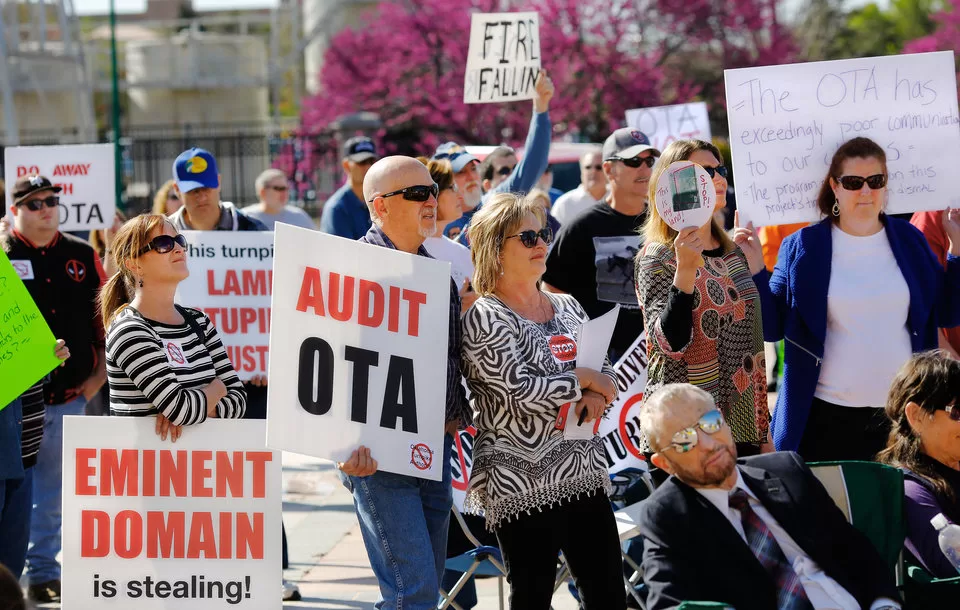
Oklahoma, Take Your Eyes Off the Road. Part 3 of the “Oklahoma, you have a turnpike problem” series
**Originally written by Katherine (Tassie) Hirschfeld, Ph.D., in July 2022. Updated December 2022 and printed here with permission of author.**
Oklahomans, what are we going to do about the Turnpike problem? It has only gotten worse since my first column back in May (Part 1). Despite multiple lawsuits alleging serious illegalities on the part of the Turnpike Authority, the state legislature declined to authorize a basic performance audit and the OTA is still trying to move ahead with its aggressive $5 billion expansion plans.
If all of the lawsuits are successful, they will create a reprieve for communities in the path of the planned Access Oklahoma turnpike extensions. But the larger Turnpike problems will persist as long as the legislature allows the OTA to operate without adequate oversight or accountability. In other words, the Turnpike problem is fundamentally a governance problem.
Some readers may be confused: isn’t the Turnpike Authority a private entity that does not receive tax dollars? Yes and no. The OTA is a hybrid public-private entity, but one that has been configured in a way that embodies the worst of both worlds. It operates like a poorly performing business that has been shielded from failure by a poorly performing state government (See Bryan Armstrong’s great post about this here).
These dynamics become visible if we take our eyes off the roadways and look at the internal organization, operations and incentive structure of the Turnpike Authority itself.
In Oklahoma’s state budget documents the OTA is described as one of six “discretely presented component units” within the state government. This means the OTA is allowed to function more like a private business than a government agency. But OTA still has significant government power, including the power to seize private property through eminent domain. This makes the OTA a public-private entity, but one without much oversight from the public or private sector.
Private sector enterprises are compelled to operate efficiently by laws of supply and demand. But there is minimal demand for toll roads, and toll rates are not set by market forces. So there is no market mechanism to guarantee efficient operations inside the OTA.
Public sector transportation enterprises are supposed to be regulated by elected officials so that there is oversight from below (from citizens) and above (from an independent state transportation commissioner). But Oklahoma concentrates power over the entire state transportation system into the hands of a single unelected official. He simultaneously wears three hats as the head of ODOT, OTA and the state Transportation Commissioner. He reports only to the Governor and a board of the Governor’s appointees. With this kind of organizational structure there are not enough checks or balances to ensure sound financial management, accountability or transparency. Instead there is a good deal of risk for corruption.
Is the Oklahoma Turnpike Authority corrupt? This question is difficult to answer. Not all corrupt practices rise to the level of illegality, and not all illegalities are prosecutable. So any specific charges of corruption would be for others to determine. But there is a more general tool anti-corruption researchers use in situations like this known simply as “the smell test.” And in my professional opinion, the operations of the Oklahoma Turnpike Authority do not pass.
One set of red flags for potential corruption can be seen in the Turnpike Authority’s questionable financial management. The recently completed Gilcrease extension project in Tulsa, for instance, was originally budgeted as a $28 million bridge project and somehow expanded into a new five mile turnpike that cost well over $300 million. The entire 2015 Driving Forward program budget somehow exploded from $800 million to approximately $1.5 billion.
In most workplaces a leadership team that had a consistent record of excessive borrowing, wild cost overruns and increasingly vocal public disapproval could expect to see some kind of penalty sanction in an end of year review. But last December the OTA board unanimously voted to award the Agency’s director a large salary increase, making him the highest paid public official in the state.
It is important to remember that a toll is a tax. The Turnpike Authority does not have an incentive to be efficient because it can levy its own taxes on the public, independent of the state’s regular taxation system. It is also important to remember that a bond is a debt. The Turnpike Authority has an unlimited ability to borrow money in the form of bond offerings, which is another disincentive for good management. Credit rating agencies do provide assessments for each bond offering. But these analyses are intended to protect investors from potential default, not to protect citizens from unnecessary turnpike construction, inflated construction costs, excessive executive compensation or price gouging at toll booths.
Ratings agencies know that as long as tolls can be increased the risk of default is low. So even turnpikes with unsustainable levels of debt can still receive “investment grade” ratings when they want to borrow money. In fact, a recent Moody’s credit rating report for the OTA states plainly, “The [Turnpike] Authority has sole authority to raise toll rates in the future above the current toll rate schedule to support its debt service requirements.” In my previous column I described how these dynamics led to a terrible situation in Pennsylvania, where $12 billion in highway bond debt led to truly predatory taxation of drivers on the state Turnpike.
Another red flag in the Oklahoma Turnpike Authority’s operations comes from its unregulated undisclosed real estate dealings. Real estate is of particular concern to anti-corruption researchers because it is one of the few assets that can be bought and sold through shell companies, so the owners can remain anonymous.
According to its 2021 financial report, the Oklahoma Turnpike Authority owns approximately $300 million worth of land. Where is this land? How and why was it purchased and for what price? We don’t know. None of the Agency’s real estate transactions are disclosed in its annual budget documents or financial reports. The value of the OTA’s land holdings has fluctuated up and down by millions of dollars over the past few years, indicating that land purchases and sales have occurred. But no details of these transactions are provided.
When OTA uses its powers of eminent domain to acquire land by force, the value is estimated through an appraisal process that has the potential to be quite inaccurate given the historic volatility of land values near planned roadways. When the OTA purchases land from voluntary sellers, it may do so without disclosing information that could affect the value of that land, such as plans for a new roadway. Unlike its land purchases, OTA’s land sales are conducted in the form of auctions so that there is competitive bidding. This gives OTA the ability to acquire land at artificially low prices, often against the will of property owners, and sell land at competitive market prices to the highest bidders.
Does any of this sound like the actions of a government agency that is working on behalf of citizens? Or does the Turnpike Authority sound more like an autocratic state-within-the-state, borrowing money and levying taxes with no oversight or accountability, while running a multi million dollar real estate business on the side?
Since the 1980s at least six bills have been introduced in the state legislature to abolish the Oklahoma Turnpike Authority. Back in 2001 one state representative (a Republican from Broken Arrow) stated in the Journal Record, “Oklahomans object to this never- ending, ever-expanding system of turnpikes paid for with ever-increasing tolls. This has become an issue of integrity.” Twenty years later Oklahomans are still objecting, the turnpike system is still expanding, tolls are still increasing and the OTA’s integrity issues are an even bigger problem.
Can we all finally agree that it’s long past time for a thorough performance audit and reorganization of this Agency so that it better serves the citizens of Oklahoma? At the very least, the OTA should be overseen by an independent Transportation Commissioner, undergo thorough annual performance reviews, disclose all of its real estate transactions and develop a plan to retire (rather than expand) its billions of dollars in debt. And finally, the OTA should be required to pay a true market price for any real estate it seeks to acquire. What is a true market price? It is not an appraised value but the point at which a buyer meets a seller. And if a seller chooses not to sell at any price? Find another route.




